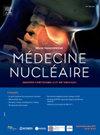Preclinical evaluation of theranostic strategy using nanoplatform and transferrin to target hyperactivity of cMYC in the context of non-small cell lung cancer
IF 0.2
4区 医学
Q4 PATHOLOGY
Medecine Nucleaire-Imagerie Fonctionnelle et Metabolique
Pub Date : 2025-02-01
DOI:10.1016/j.mednuc.2024.12.056
引用次数: 0
Abstract
NSCLC affects 1.3 million people annually worldwide. The cMYC pathway regulates a large number of physiological processes and is hyperactivated in many cancers, including lung cancers. Due to the high avidity of cancer cells for iron, transferrin receptor complex (TFRC) has been demonstrated to be overexpressed when the cMYC pathway is hyperactivated. We propose a theranostic approach targeting TFRC through murine transferrin (Tf), able to be radiolabeled with 89-Zirconium (89Zr) for imaging or with 177-Lutetium (177Lu) for internal radiotherapy. To minimize the therapeutic dose while maximizing efficacy for managing radiotoxicity, nano-radio-enhancer agent (platinum agent, PtNP) has been used to exalt the irradiation impact. We evaluated the ability of the radiolabeled Tf to bind to TFRC thanks to in vitro pharmacology assays. C57BL/6J mice were implanted with NSCLC (CMT167, TFRC+) xenografts to establish the radiolabeled Tf biodistribution and pharmacokinetics in order to evaluate the dosimetry thanks to RODES software developed by IRSN. The distribution of the PtNP was also assessed by PET imaging for dose optimization. Finally, we injected mice beating CMT167 tumors with [177Lu]Lu-Transferrin ([177Lu]Lu-Tf) to monitor the therapeutic effect of this molecule with or without the addition of PtNP, by tracking tumor volume. The high expression levels of TFRC in the liver involve a large exposition of the radiolabeled Tf (AUC = 2066 h.%ID.cm-3) and can be a potential limitation to the use of Tf as an internal radiotherapy agent. However, its great accumulation in the tumor (9.8 ± 1.1%ID.cm-3 24 hours post-injection, AUC = 1257 h.%ID.cm-3) makes it a promising candidate if the dose can be potentialized thanks to the PtNP radio-enhancing approach. PtNP distribution levels were of 5.0 ± 0.8%ID.cm-3 24 h post-injection, corresponding to 10.3 ± 0.9 mM of PtNP concentration known to elicit cytotoxicity upon external irradiation. Initial therapeutic assays involving [177Lu]Lu-Tf, either co-injected or not with PtNP, demonstrated a reduction in tumor volume compared to the control group (61.2% and 49.6% reduction in tumor volume respectively 21 days post-injection). The therapeutic impact of PtNP slightly enhanced therapeutic efficacy while significantly stabilizing tumor volume. TFRC can be a potent therapeutic target in the case of cMYC/mTOR dysregulation. The use of a moderate dose of [177Lu]Lu-Tf appears to provide therapeutic efficacy while avoiding toxicity.
求助全文
约1分钟内获得全文
求助全文
来源期刊
CiteScore
0.30
自引率
0.00%
发文量
160
审稿时长
19.8 weeks
期刊介绍:
Le but de Médecine nucléaire - Imagerie fonctionnelle et métabolique est de fournir une plate-forme d''échange d''informations cliniques et scientifiques pour la communauté francophone de médecine nucléaire, et de constituer une expérience pédagogique de la rédaction médicale en conformité avec les normes internationales.

 求助内容:
求助内容: 应助结果提醒方式:
应助结果提醒方式:


